Twin Induced Reduction of Seismic Anisotropy in Lawsonite Blueschist
Abstract
1. Introduction
2. Geological Overview
3. Methods
4. Results
4.1. Microstructures
4.2. CPOs of Lawsonite and Glaucophane
4.2.1. CPOs and CPO Strength of Lawsonite
4.2.2. CPO of Glaucophane
4.3. Seismic Velocity and Anisotropy of Minerals and Whole Rocks
5. Discussion
5.1. CPO of Lawsonite and Effect of Twins on the CPO Strength of Lawsonite
5.2. Effect of Lawsonite Twinning on Seismic Anisotropy in Subducting Oceanic Crust
6. Conclusions
Author Contributions
Funding
Data Availability Statement
Conflicts of Interest
References
- Savage, M. Seismic anisotropy and mantle deformation: What have we learned from shear wave splitting? Rev. Geophys. 1999, 37, 65–106. [Google Scholar] [CrossRef]
- Long, M.D.; Silver, P.G. The subduction zone flow field from seismic anisotropy: A global view. Science 2008, 319, 315–318. [Google Scholar] [CrossRef]
- Long, M.D. Constraints on Subduction Geodynamics from Seismic Anisotropy. Rev. Geophys. 2013, 51, 76–112. [Google Scholar] [CrossRef]
- Zhao, D.; Yu, S.; Liu, X. Seismic anisotropy tomography: New insight into subduction dynamics. Gondwana Res. 2016, 33, 24–43. [Google Scholar] [CrossRef]
- Healy, D.; Reddy, S.M.; Timms, N.E.; Gray, E.M.; Brovarone, A.V. Trench-parallel fast axes of seismic anisotropy due to fluid-filled cracks in subducting slabs. Earth Planet. Sci. Lett. 2009, 283, 75–86. [Google Scholar] [CrossRef]
- Wang, J.; Zhao, D. Mapping P-wave anisotropy of the Honshu arc from Japan Trench to the back-arc. J. Asian Earth Sci. 2010, 39, 396–407. [Google Scholar] [CrossRef]
- Jung, H. Crystal preferred orientations of olivine, orthopyroxene, serpentine, chlorite, and amphibole, and implications for seismic anisotropy in subduction zones: A review. Geosci. J. 2017, 21, 985–1011. [Google Scholar] [CrossRef]
- Almqvist, B.S.; Mainprice, D. Seismic properties and anisotropy of the continental crust: Predictions based on mineral texture and rock microstructure. Rev. Geophys. 2017, 55, 367–433. [Google Scholar] [CrossRef]
- Cao, Y.; Jung, H.; Song, S. Microstructures and petro-fabrics of lawsonite blueschist in the North Qilian suture zone, NW China: Implications for seismic anisotropy of subducting oceanic crust. Tectonophysics 2014, 628, 140–157. [Google Scholar] [CrossRef]
- Cao, Y.; Jung, H. Seismic properties of subducting oceanic crust: Constraints from natural lawsonite-bearing blueschist and eclogite in Sivrihisar Massif, Turkey. Phys. Earth Planet. Inter. 2016, 250, 12–30. [Google Scholar] [CrossRef]
- Kim, D.; Katayama, I.; Michibayashi, K.; Tsujimori, T. Deformation fabrics of natural blueschists and implications for seismic anisotropy in subducting oceanic crust. Phys. Earth Planet. Inter. 2013, 222, 8–21. [Google Scholar] [CrossRef]
- Kim, D.; Wallis, S.; Endo, S.; Ree, J.-H. Seismic properties of lawsonite eclogites from the southern Motagua fault zone, Guatemala. Tectonophysics 2016, 677–678, 88–98. [Google Scholar] [CrossRef]
- Park, M.; Jung, H. Relationships Between Eclogite-Facies Mineral Assemblages, Deformation Microstructures, and Seismic Properties in the Yuka Terrane, North Qaidam Ultrahigh-Pressure Metamorphic Belt, NW China. J. Geophys. Res. Solid Earth 2019, 124, 13168–13191. [Google Scholar] [CrossRef]
- Iizuka-Oku, R.; Soustelle, V.; Miyajima, N.; Walte, N.P.; Frost, D.J.; Yagi, T. Experimentally deformed lawsonite at high pressure and high temperature: Implication for low velocity layers in subduction zones. Phys. Earth Planet. Inter. 2019, 295, 106282. [Google Scholar] [CrossRef]
- Fornash, K.F.; Whitney, D.L.; Seaton, N.C.A. Lawsonite composition and zoning as an archive of metamorphic processes in subduction zones. Geosphere 2018, 15, 24–46. [Google Scholar] [CrossRef]
- Whitney, D.L.; Fornash, K.F.; Kang, P.; Ghent, E.D.; Martin, L.; Okay, A.I.; Vitale Brovarone, A. Lawsonite composition and zoning as tracers of subduction processes: A global review. Lithos 2020, 370–371, 105636. [Google Scholar] [CrossRef]
- Tsujimori, T.; Ernst, W.G. Lawsonite blueschists and lawsonite eclogites as proxies for palaeo-subduction zone processes: A review. J. Metamorph. Geol. 2014, 32, 437–454. [Google Scholar] [CrossRef]
- Tamblyn, R.; Hand, M.; Morrissey, L.; Zack, T.; Phillips, G.; Och, D. Resubduction of lawsonite eclogite within a serpentinite-filled subduction channel. Contrib. Mineral. Petrol. 2020, 175. [Google Scholar] [CrossRef]
- Vitale-Brovarone, A.; Groppo, C.; HetÉNyi, G.; Compagnoni, R.; Malavieille, J. Coexistence of lawsonite-bearing eclogite and blueschist: Phase equilibria modelling of Alpine Corsica metabasalts and petrological evolution of subducting slabs. J. Metamorph. Geol. 2011, 29, 583–600. [Google Scholar] [CrossRef]
- Fabbri, O.; Magott, R.; Fournier, M.; Etienne, L. Pseudotachylyte in the Monte Maggiore ophiolitic unit (Alpine Corsica): a possible lateral extension of the Cima di Gratera intermediate-depth Wadati-Benioff paleo-seismic zone. Earth Sci. Bull. 2018, 189, 18. [Google Scholar] [CrossRef]
- Vitale-Brovarone, A.; Beltrando, M.; Malavieille, J.; Giuntoli, F.; Tondella, E.; Groppo, C.; Beyssac, O.; Compagnoni, R. Inherited Ocean–Continent Transition zones in deeply subducted terranes: Insights from Alpine Corsica. Lithos 2011, 124, 273–290. [Google Scholar] [CrossRef]
- Vitale-Brovarone, A.; Picatto, M.; Beyssac, O.; Lagabrielle, Y.; Castelli, D. The blueschist–eclogite transition in the Alpine chain: P–T paths and the role of slow-spreading extensional structures in the evolution of HP–LT mountain belts. Tectonophysics 2014, 615–616, 96–121. [Google Scholar] [CrossRef]
- Ravna, E.J.K.; Andersen, T.B.; Jolivet, L.; de Capitani, C. Cold subduction and the formation of lawsonite eclogite — constraints from prograde evolution of eclogitized pillow lava from Corsica. J. Metamorph. Geol. 2010, 28, 381–395. [Google Scholar] [CrossRef]
- Caron, J.-M.; Péquignot, G. The transition between blueschists and lawsonite-bearing eclogites based on observations from Corsican metabasalts. Lithos 1986, 19, 205–218. [Google Scholar] [CrossRef]
- Brunet, C.; Monié, P.; Jolivet, L.; Cadet, J.-P. Migration of compression and extension in the Tyrrhenian Sea, insights from 40Ar/39Ar ages on micas along a transect from Corsica to Tuscany. Tectonophysics 2000, 321, 127–155. [Google Scholar] [CrossRef]
- Vitale-Brovarone, A.; Beyssac, O.; Malavieille, J.; Molli, G.; Beltrando, M.; Compagnoni, R. Stacking and metamorphism of continuous segments of subducted lithosphere in a high-pressure wedge: The example of Alpine Corsica (France). Earth-Sci. Rev. 2013, 116, 35–56. [Google Scholar] [CrossRef]
- Vitale-Brovarone, A.; Herwartz, D. Timing of HP metamorphism in the Schistes Lustrés of Alpine Corsica: New Lu–Hf garnet and lawsonite ages. Lithos 2013, 172, 175–191. [Google Scholar] [CrossRef]
- Austrheim, H.; Andersen, T.B. Pseudotachylytes from Corsica: Fossil earthquakes from a subduction complex. Terra Nova 2004, 16, 193–197. [Google Scholar] [CrossRef]
- Plunder, A.; Agard, P.; Chopin, C.; Okay, A.I. Geodynamics of the Tavşanlı zone, western Turkey: Insights into subduction/obduction processes. Tectonophysics 2013, 608, 884–903. [Google Scholar] [CrossRef]
- Topuz, G.; Okay, A.; Altherr, R.; Meyer, H.P.; Nasdala, L. Partial high-pressure aragonitization of micritic limestones in an accretionary complex, Tavşanlı Zone, NW Turkey. J. Metamorph. Geol. 2006, 24, 603–613. [Google Scholar] [CrossRef]
- Okay, A.I.; Harris, N.B.; Kelley, S.P. Exhumation of blueschists along a Tethyan suture in northwest Turkey. Tectonophysics 1998, 285, 275–299. [Google Scholar] [CrossRef]
- Pourteau, A.; Scherer, E.E.; Schorn, S.; Bast, R.; Schmidt, A.; Ebert, L. Thermal evolution of an ancient subduction interface revealed by Lu–Hf garnet geochronology, Halilbağı Complex (Anatolia). Geosci. Front. 2019, 10, 127–148. [Google Scholar] [CrossRef]
- Sherlock, S.; Kelley, S.; Inger, S.; Harris, N.; Okay, A. 40 Ar-39 Ar and Rb-Sr geochronology of high-pressure metamorphism and exhumation history of the Tavsanli Zone, NW Turkey. Contrib. Mineral. Petrol. 1999, 137, 46–58. [Google Scholar]
- Davis, P.B.; Whitney, D.L. Petrogenesis and structural petrology of high-pressure metabasalt pods, Sivrihisar, Turkey. Contrib. Mineral. Petrol. 2008, 156, 217–241. [Google Scholar] [CrossRef]
- Davis, P.B.; Whitney, D.L. Petrogenesis of lawsonite and epidote eclogite and blueschist, Sivrihisar Massif, Turkey. J. Metamorph. Geol. 2006, 24, 823–849. [Google Scholar] [CrossRef]
- Malavieille, J.; Chemenda, A.; Larroque, C. Evolutionary model for Alpine Corsica: Mechanism for ophiolite emplacement and exhumation of high-pressure rocks. Terra Nova-Oxf. 1998, 10, 317–322. [Google Scholar] [CrossRef]
- Danišík, M.; Kuhlemann, J.; Dunkl, I.; Evans, N.J.; Székely, B.; Frisch, W. Survival of ancient landforms in a collisional setting as revealed by combined fission track and (U-Th)/He thermochronometry: A case study from Corsica (France). J. Geol. 2012, 120, 155–173. [Google Scholar] [CrossRef]
- Panozzo, R. Two-dimensional strain from the orientation of lines in a plane. J. Struct. Geol. 1984, 6, 215–221. [Google Scholar] [CrossRef]
- Park, M.; Jung, H. Analysis of electron backscattered diffraction (EBSD) mapping of geological materials: Precautions for reliably collecting and interpreting data on petro-fabric and seismic anisotropy. Geosci. J. 2020, 24, 679–687. [Google Scholar] [CrossRef]
- Skemer, P.; Katayama, I.; Jiang, Z.; Karato, S.-i. The misorientation index: Development of a new method for calculating the strength of lattice-preferred orientation. Tectonophysics 2005, 411, 157–167. [Google Scholar] [CrossRef]
- Sinogeikin, S.V.; Schilling, F.R.; Bass, J.D. Single crystal elasticity of lawsonite. Am. Mineral. 2000, 85, 1834–1837. [Google Scholar] [CrossRef]
- Bezacier, L.; Reynard, B.; Bass, J.D.; Wang, J.; Mainprice, D. Elasticity of glaucophane, seismic velocities and anisotropy of the subducted oceanic crust. Tectonophysics 2010, 494, 201–210. [Google Scholar] [CrossRef]
- Mainprice, D. A FORTRAN program to calculate seismic anisotropy from the lattice preferred orientation of minerals. Comput. Geosci. 1990, 16, 385–393. [Google Scholar] [CrossRef]
- Walton, W. Feret’s statistical diameter as a measure of particle size. Nature 1948, 162, 329–330. [Google Scholar] [CrossRef]
- Fujimoto, Y.; Kono, Y.; Hirajima, T.; Kanagawa, K.; Ishikawa, M.; Arima, M. P-wave velocity and anisotropy of lawsonite and epidote blueschists: Constraints on water transportation along subducting oceanic crust. Phys. Earth Planet. Inter. 2010, 183, 219–228. [Google Scholar] [CrossRef]
- Keppler, R.; Behrmann, J.H.; Stipp, M. Textures of eclogites and blueschists from Syros island, Greece: Inferences for elastic anisotropy of subducted oceanic crust. J. Geophys. Res. Solid Earth 2017, 122, 5306–5324. [Google Scholar] [CrossRef]
- Abdullah, S.; Misra, S.; Sarvesha, R.; Ghosh, B. Resurfacing of deeply buried oceanic crust in Naga Hills Ophiolite, North-East India: Petrofabric, microstructure and seismic properties. J. Struct. Geol. 2020, 139. [Google Scholar] [CrossRef]
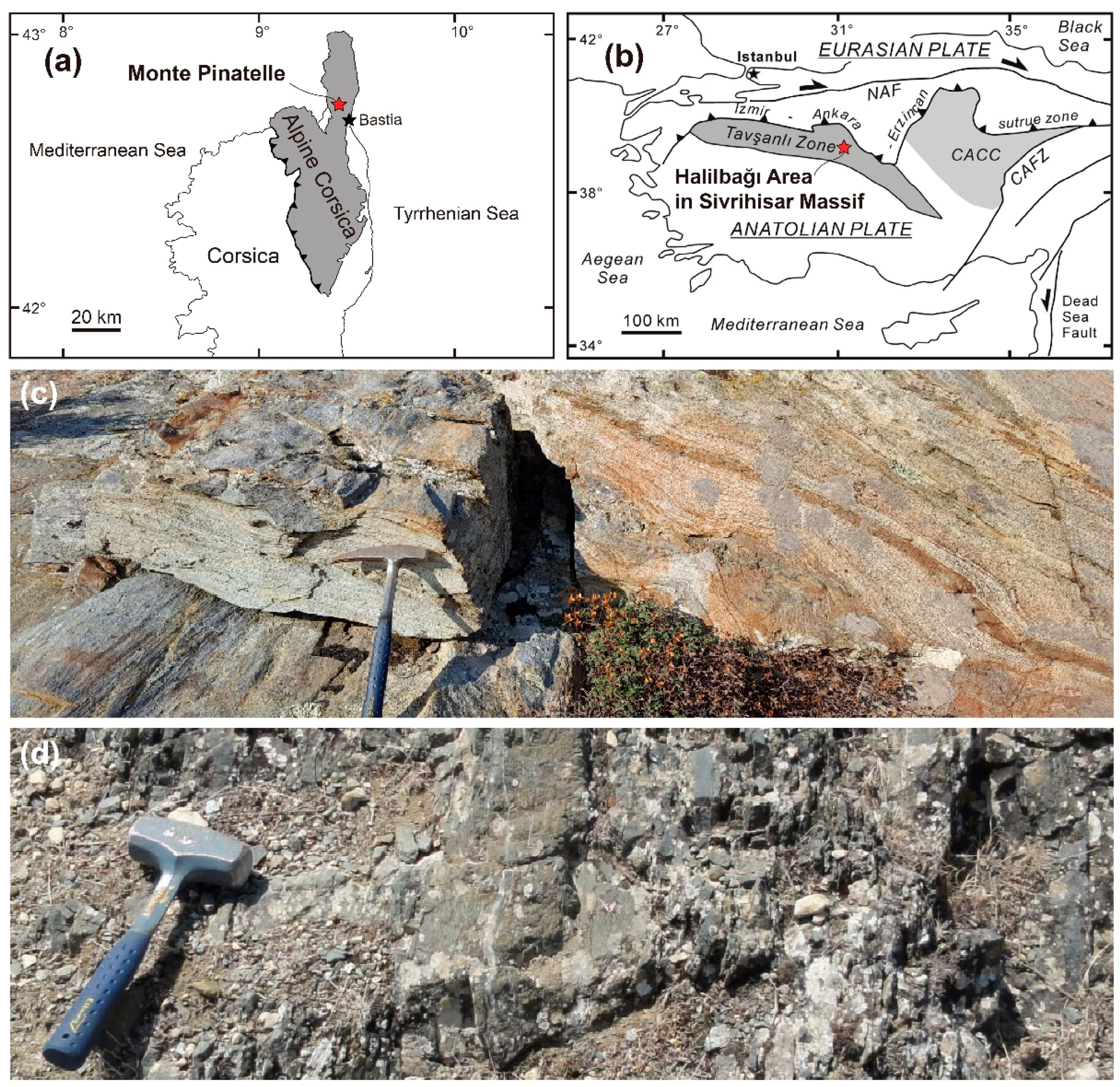
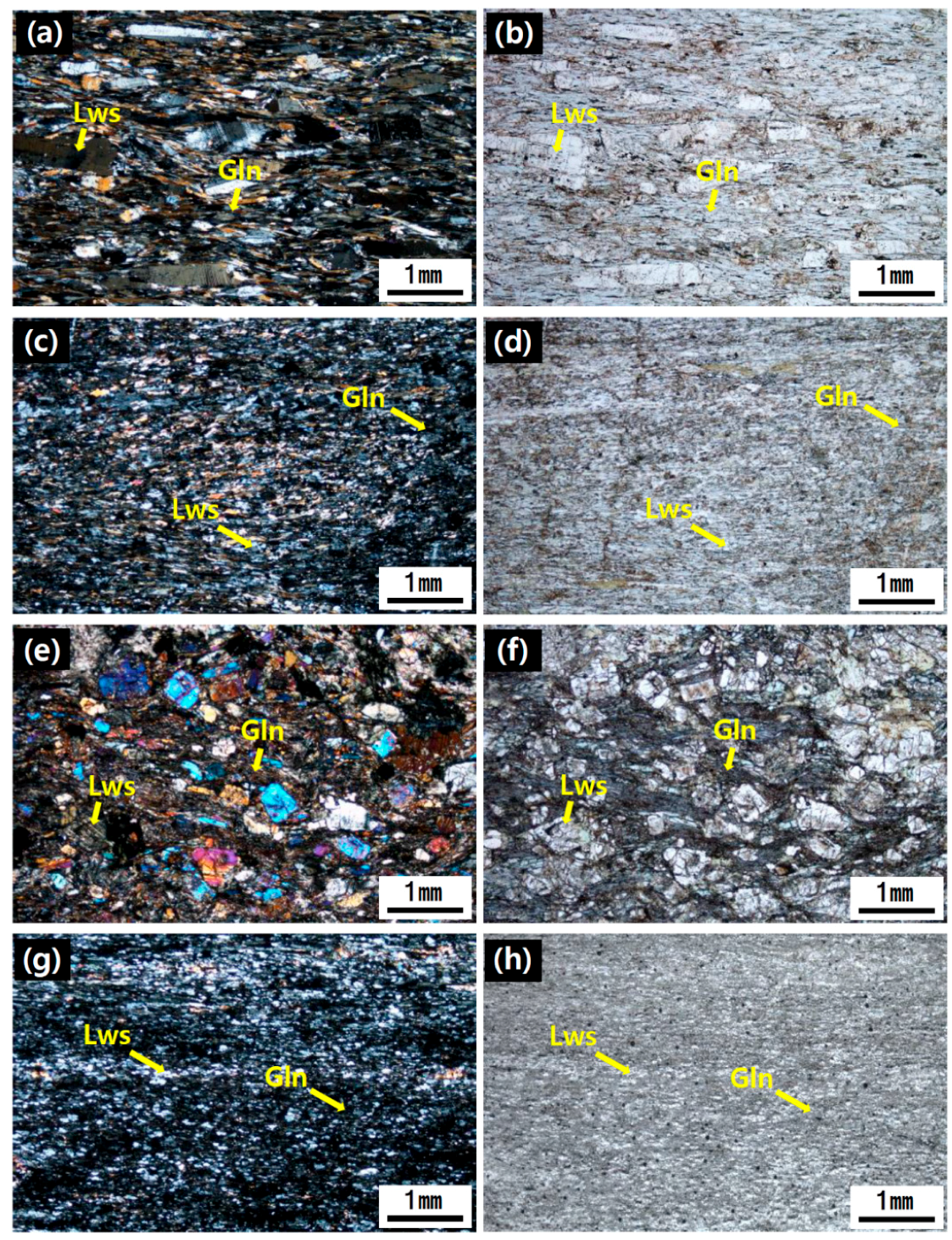

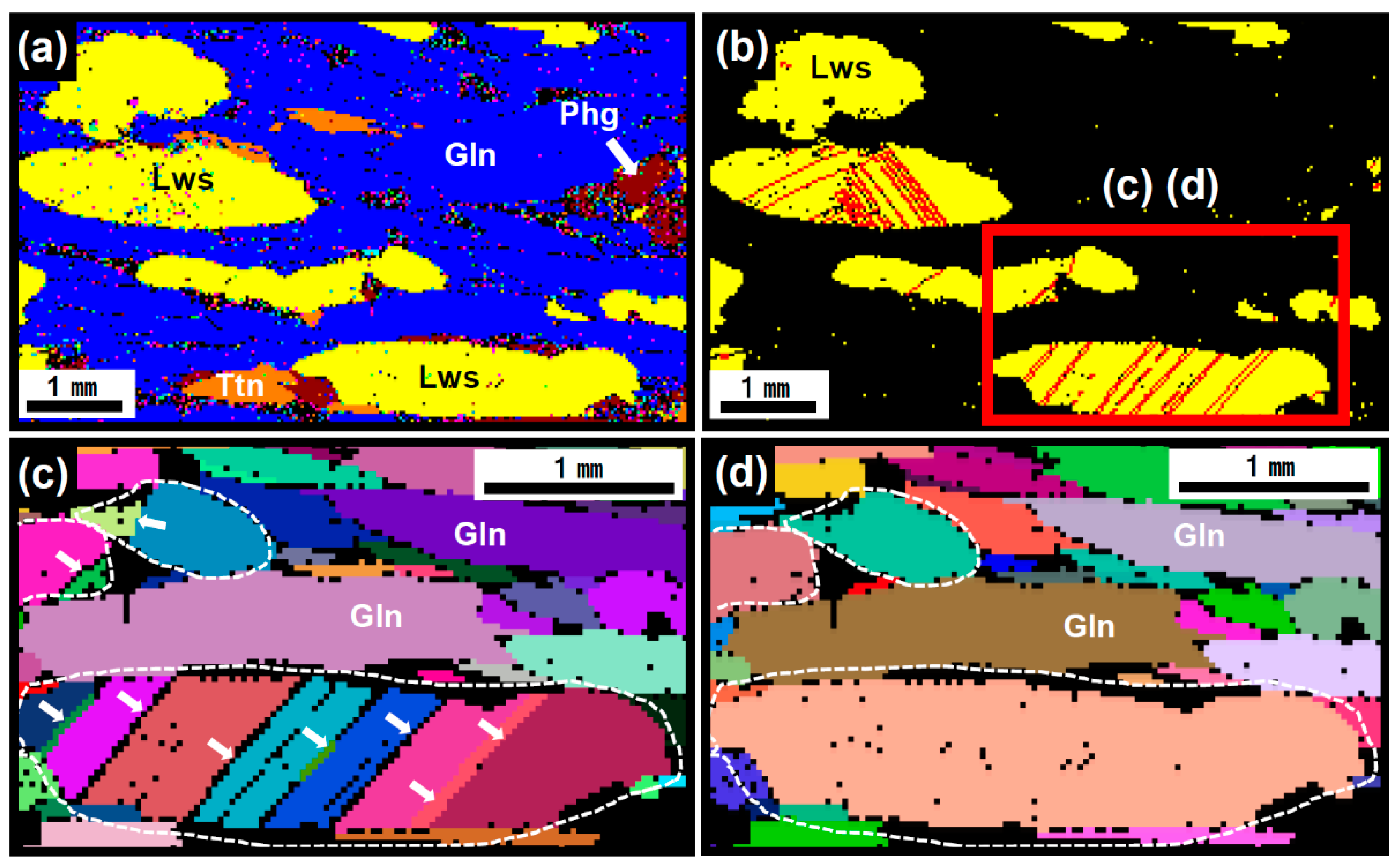
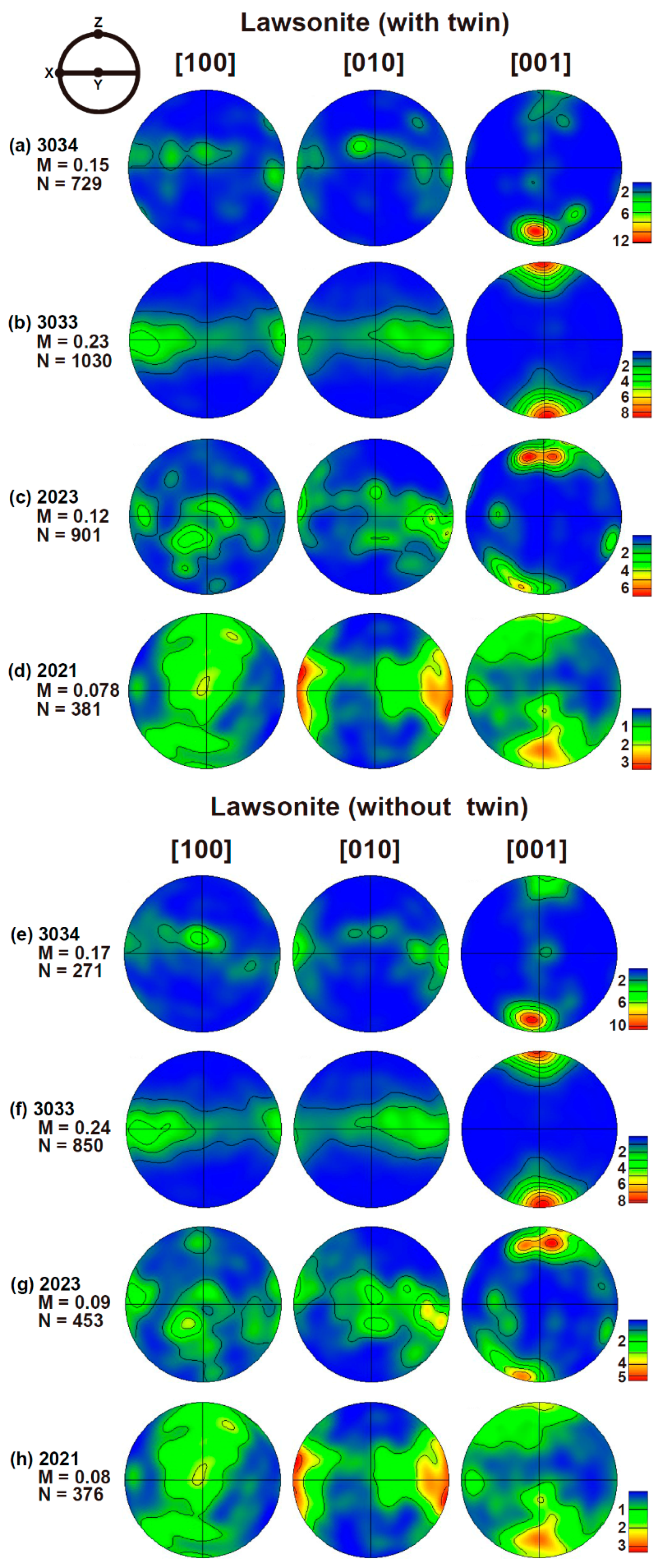
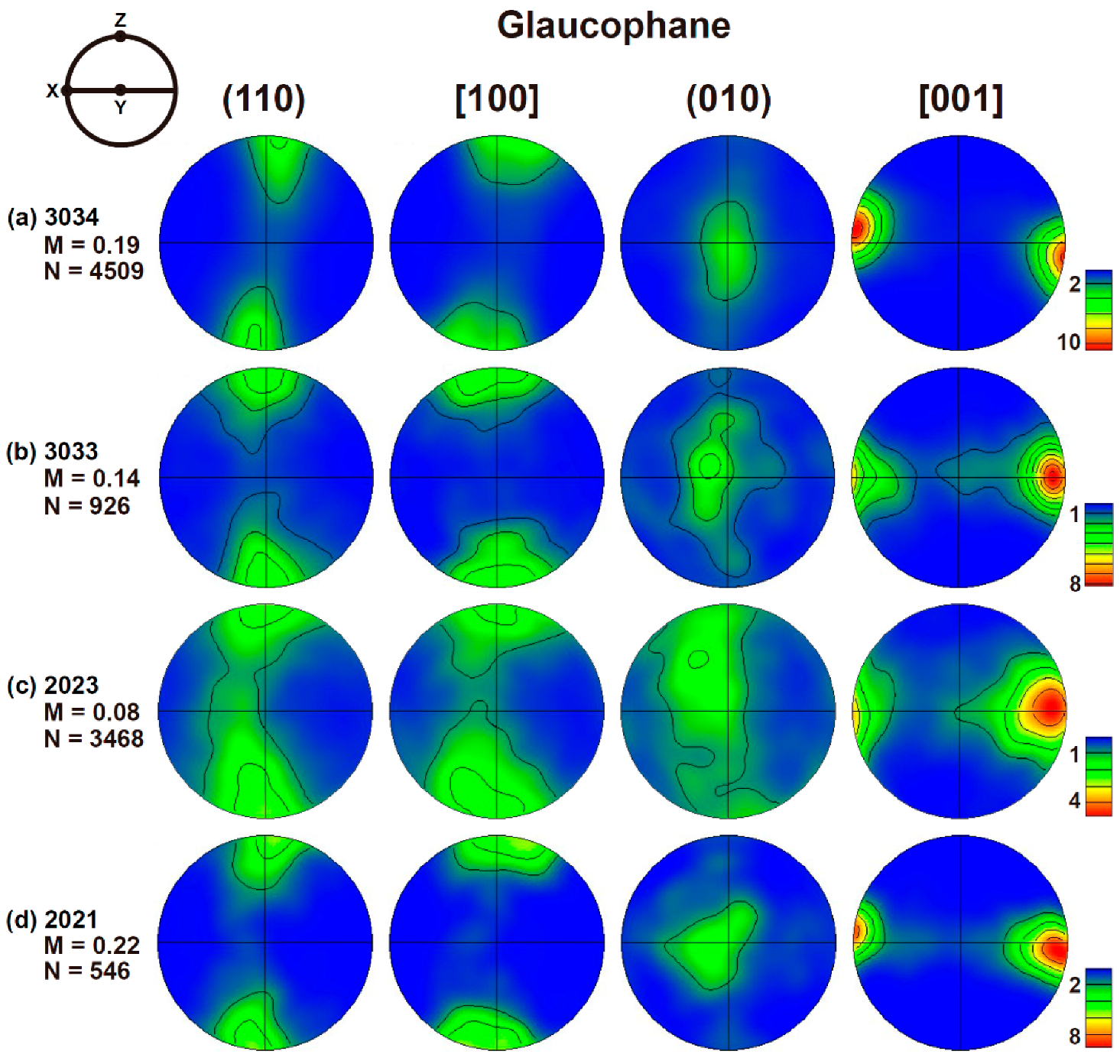
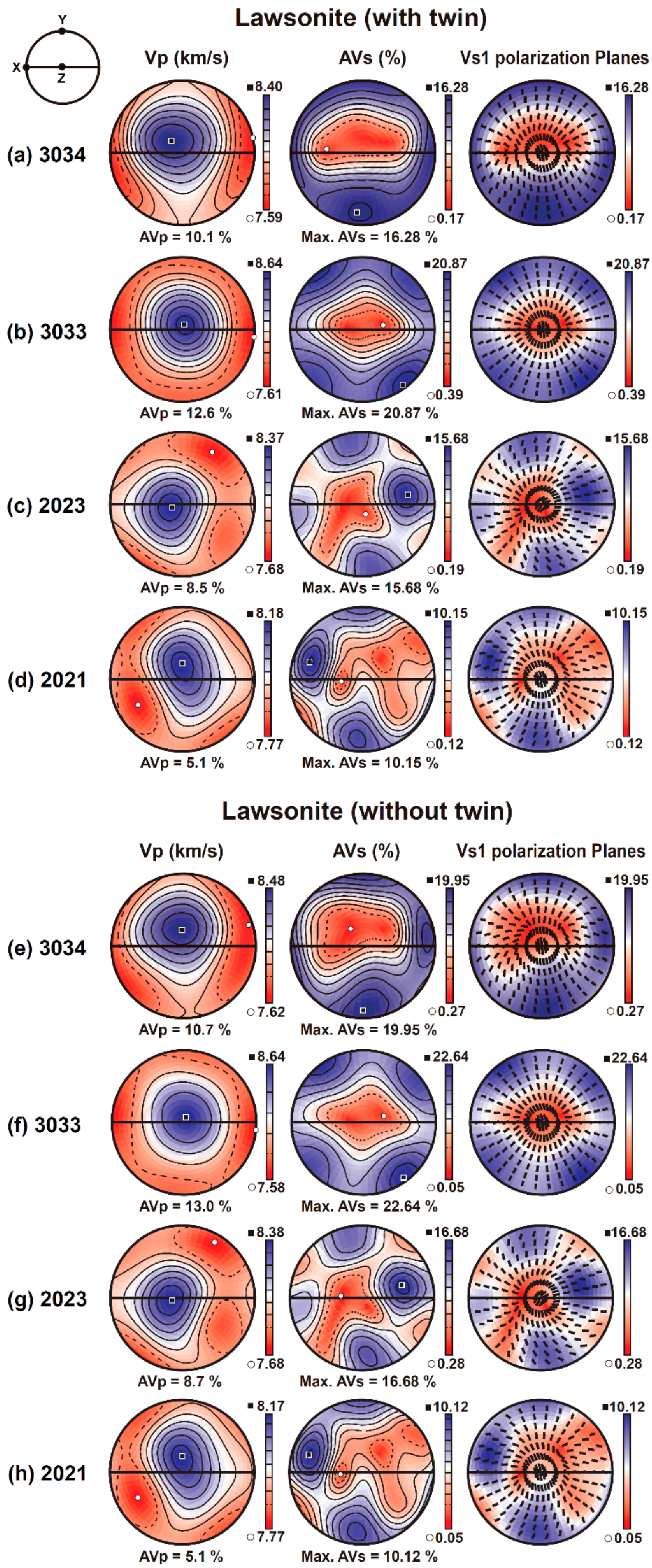
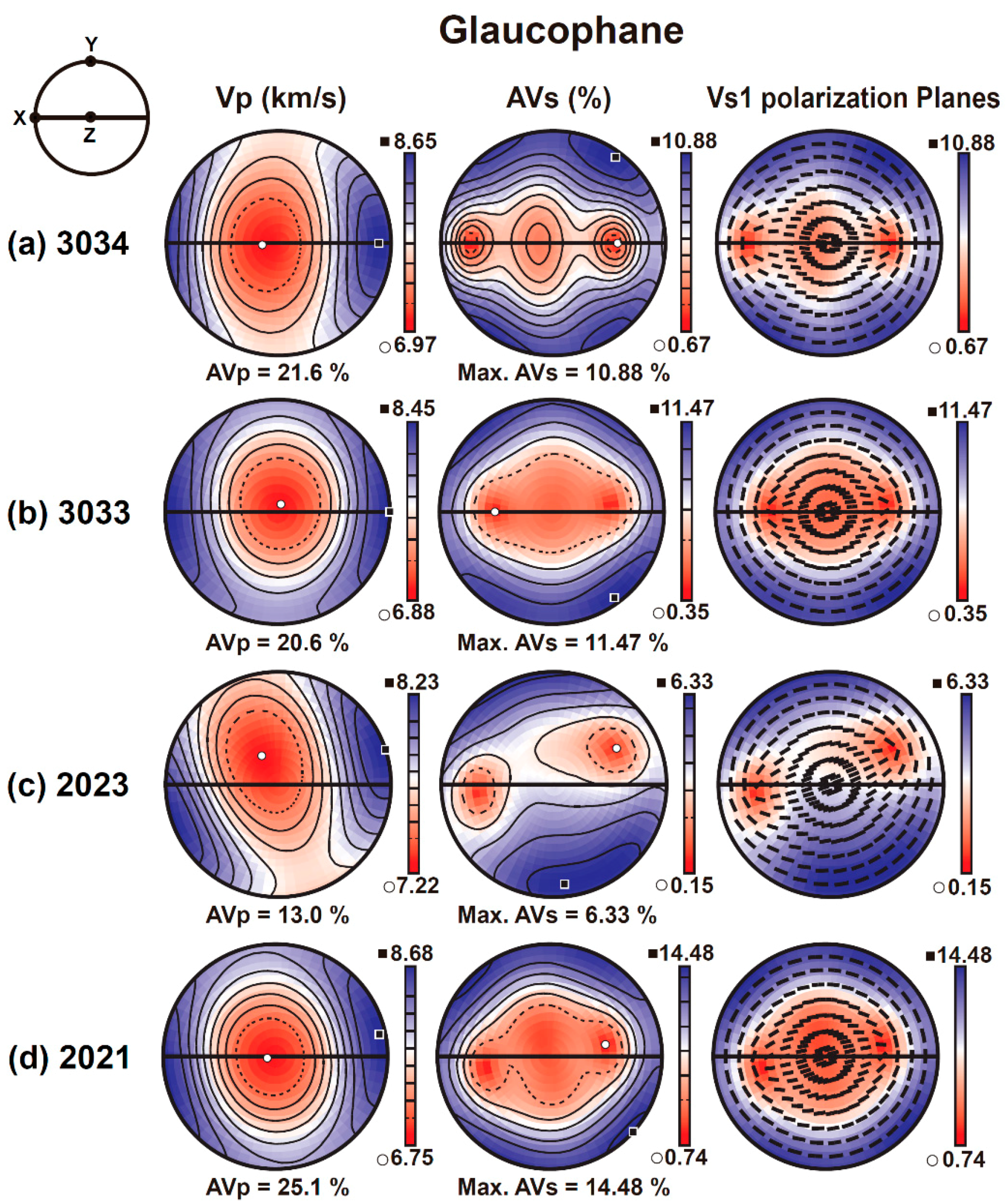
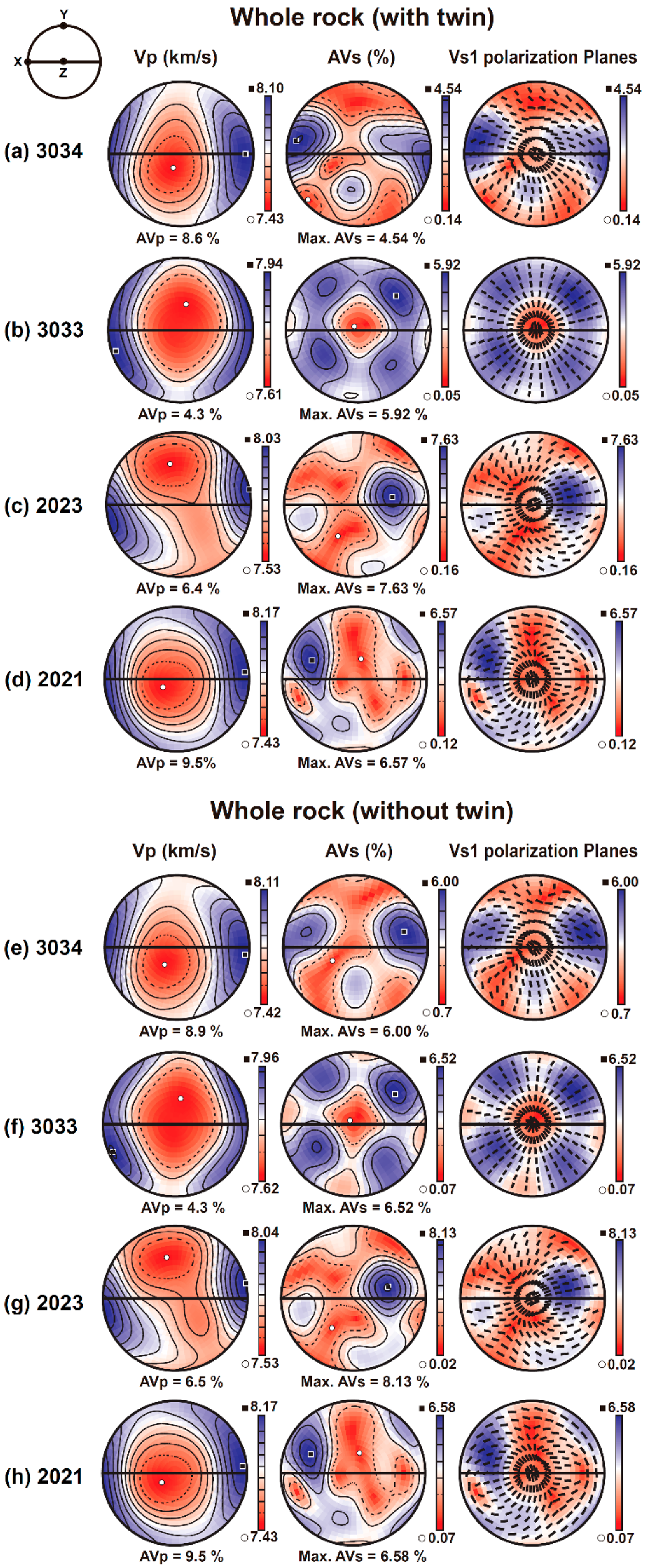
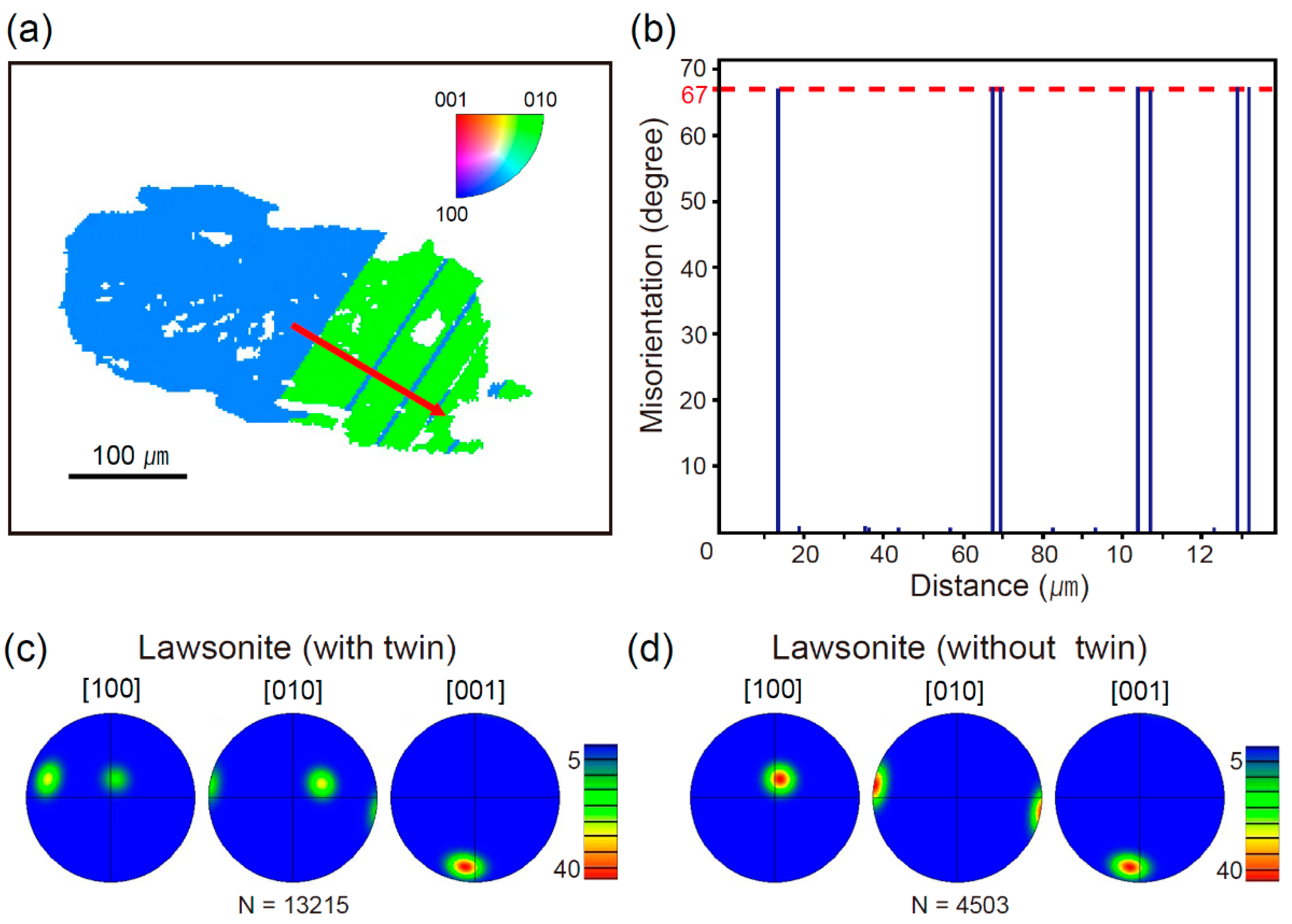
| Sample | Location | Major Minerals 1 | Grain Size (µm) 2 | Twin Frequency 3 | Fraction of Twinned Area (%) 3 | CPO Strength 4 | ||
|---|---|---|---|---|---|---|---|---|
| Lws (%) | Gln (%) | M1 | M2 | |||||
| 3034 | Corsica | 37 | 63 | 104 | High | 31.4 | 0.15 | 0.17 |
| 3033 | Corsica | 45 | 55 | 29 | Middle | 15.5 | 0.23 | 0.24 |
| 2023 | Sivrihisar | 43 | 57 | 106 | Low | 12.9 | 0.12 | 0.09 |
| 2021 | Sivrihisar | 53 | 47 | 38 | Very low | 0.6 | 0.078 | 0.080 |
| Sample | Twin | Lawsonite | Whole Rock | ||
|---|---|---|---|---|---|
| AVp (%) | Max AVs (%) | AVp (%) | Max AVs (%) | ||
| 3034 | with twin | 10.10 | 16.28 | 8.60 | 4.54 |
| without twin | 10.70 | 19.95 | 8.90 | 6.00 | |
| −0.60% 1 | −3.67% | −0.30% | −1.46% | ||
| 3033 | with twin | 12.60 | 20.87 | 4.30 | 5.92 |
| without twin | 13.00 | 22.64 | 4.30 | 6.52 | |
| −0.40% | −1.77% | 0% | −0.60% | ||
| 2023 | with twin | 8.50 | 15.68 | 6.40 | 7.63 |
| without twin | 8.70 | 16.68 | 6.50 | 8.13 | |
| −0.20% | −1.00% | −0.10% | −0.50% | ||
| 2021 | with twin | 5.10 | 10.15 | 9.50 | 6.57 |
| without twin | 5.10 | 10.12 | 9.50 | 6.58 | |
| 0% | 0.30% | 0% | –0.01% | ||
Publisher’s Note: MDPI stays neutral with regard to jurisdictional claims in published maps and institutional affiliations. |
© 2021 by the authors. Licensee MDPI, Basel, Switzerland. This article is an open access article distributed under the terms and conditions of the Creative Commons Attribution (CC BY) license (https://creativecommons.org/licenses/by/4.0/).
Share and Cite
Choi, S.; Fabbri, O.; Topuz, G.; Okay, A.I.; Jung, H. Twin Induced Reduction of Seismic Anisotropy in Lawsonite Blueschist. Minerals 2021, 11, 399. https://doi.org/10.3390/min11040399
Choi S, Fabbri O, Topuz G, Okay AI, Jung H. Twin Induced Reduction of Seismic Anisotropy in Lawsonite Blueschist. Minerals. 2021; 11(4):399. https://doi.org/10.3390/min11040399
Chicago/Turabian StyleChoi, Seungsoon, Olivier Fabbri, Gültekin Topuz, Aral I. Okay, and Haemyeong Jung. 2021. "Twin Induced Reduction of Seismic Anisotropy in Lawsonite Blueschist" Minerals 11, no. 4: 399. https://doi.org/10.3390/min11040399
APA StyleChoi, S., Fabbri, O., Topuz, G., Okay, A. I., & Jung, H. (2021). Twin Induced Reduction of Seismic Anisotropy in Lawsonite Blueschist. Minerals, 11(4), 399. https://doi.org/10.3390/min11040399







